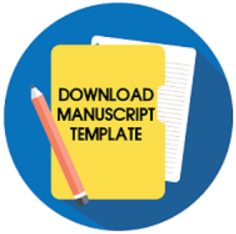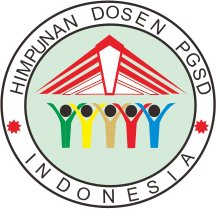The effectiveness of video and deck card use in crafting the skills of writing experience within the elementary school students
Downloads
The aims of this research are to find out (1) the differences of the use of video and random cards with pictures and worksheets on the skill of writing experience-story of fifth grade students of SD Negeri Panggang; (2) the effectiveness of the use of video and random cards compared to the pictures and worksheets on the skill of writing experience-story of fifth grade students of SD Negeri Panggang.The research approach is quantitative and the method is quasi-experimental with pretest and posttest. Based on the results of the calculation of the t-test, the score of posttest on the experimental group and the control group is 2.193 with df=38 obtained p=0.035 which are less than 5% (p <0.05). The t-test results showed that there was the difference between the skills of writing experience-story from the experimental group that uses video and random cards with pictures and worksheets. Gain score showed the differences in the level of per cent (t = 2.895; P <0.05) (t = 2.895; 0.006 <0.05). The results showed that video has more effective effects than random cards with pictures and worksheets on improving the skills of writing experience story of fifth-grade students of SD Negeri Panggang.
Downloads
Algozzine, B., & Diliberto, J. A. (2004). Improving descriptive sentence writing in elementary students. Preventing School Failure: Alternative Education for Children and Youth, 48(4), 34-36.
Alvarez, C. J., Cottrell, D., & Afonso, O. (2009). Writing dictated words and picture names: Syllabic boundaries affect execution in Spanish. Applied Psycholinguistics, 30(02), 205-223. Diambil pada tanggal 10 Desember 2015, dari http://e-resources.perpusnas.go.id
Arsyad, A. (2014). Media pembelajaran. Jakarta: Rajawali Pers.
Astuti, Y. W., & Mustadi, A. (2014). Pengaruh penggunaan media film animasi terhadap keterampilan menulis karangan narasi siswa kelas V SD. Jurnal Prima Edukasia, 2(2), 250-262. Retrieved from http://journal.uny.ac.id/index.php/jpe/article/view/2723
Azmussya'ni, A., & Wangid, M. (2014). Peningkatan keterampilan menulis menggunakan pendekatan proses dengan media gambar di SDN 3 Sakra. Jurnal Prima Edukasia, 2(1), 1-13. Retrieved from http://journal.uny.ac.id/index.php/jpe/article/view/2640
Brisk, M. E., Hodgson-Drysdale, T., & O'connor, C. H. E. R. Y. L. (2010). A study of a collaborative instructional project informed by systemic functional linguistic theory: Report writing in elementary grades. Journal of Education, 1-12. Accessed on December 10th, 2015, from http://www.bu.edu/journalofeducation/files/2011/11/BUJOE-191.1.Brisketal.pdf
Capacetti, J. (2014). Using images to teach grammatical concepts in Spanish. Picture Writing, Volume 1. Accessed on December 10th. 2015, from http://www.yale.edu/ynhti/curriculum/units/2014/1/14.01.05.x.html
í‡etinavc, U. R., & Topkaya, E. Z. (2012). A contrastive qualitative evaluation of two different sequential programs launched at the school of foreign languages of a Turkish university. Turkish Online Journal of Qualitative Inquiry, 3(3), 82-101. Accessed on December 10th, 2015, from http://e-resources.perpusnas.go.id
Dean, D., & Grierson, S. (2005). Re"envisioning reading and writing through combined"text picture books. Journal of Adolescent & Adult Literacy, 48(6), 456-468. Accessed on December 10th, 2015, from http://e-resources.perpusnas.go.id
Donoghue, M. (2009). Language arts: integrating skill classroom teaching. London: Sage Publication, Inc.
Gutiérrez, K. G. C., Puello, M. N., & Galvis, L. A. P. (2015). Using pictures series technique to enhance narrative writing among ninth grade students at institución Educativa Simón Araujo. English Language Teaching, 8(5), 45. Accessed on December 10th, 2015, from http://files.eric.ed.gov/fulltext/ej1075242.pdf
Hagiwara, H. (2007). A topographical study on the event-related potential correlates of scrambled word order in Japanese complex sentences. Journal of Cognitive Neuroscience 19, 175-93. Accessed on December 10th, 2015, from http://e-resources.perpusnas.go.id/
Halcomb, S. H., Taylor, J. P., Desouza, K. D., & Wallace, W. P. (2008). False recognition following study of semantically related lists presented in jumbled word form. Memory, 16(4), 443-461. Accessed on December 10th, 2015, from http://e-resources.perpusnas.go.id.
Hawkins, L. K., & Razali, A. B. (2012). A tale of 3 P's-penmanship, product, and process: 100 years of elementary writing instruction. Language Arts, 89(5), 305-317. Accessed on December 10th, 2015, from http://e-resources.perpusnas.go.id/
Hegelheimer, V., & Fisher, D. (2006). Grammar, writing, and technology: A sample technology-supported approach to teaching grammar and improving writing for ESL learners. CALICO journal, 257-279. Accessed on December 10th, 2015, from https://calico.org/html/article_116.pdf
Kush, D. (2013). The influence of sentential context and frequency of occurrence on the recognition of words with scrambled letters. Psychology of Language and Communication, 13(2), 45-57. Accessed on December 10th, 2015, from http://e-resources.perpusnas.go.id/
Lee, W. & Owens, D. (2004). Multimedia-based instructional design. Urbana: Wiley.
Newby, T., Stepich, D., Lehman, J., & Russell, J. (2011). Instructional technology for teaching and learning: Designing instruction, integrating computers, and using media. Educational Technology & Society, 3(2).
Phipps, S., & Borg, S. (2009). Exploring tensions between teachers' grammar teaching beliefs and practices. System, 37(3), 380-390. Accessed on December 10th, 2015, from http://www.education.leeds.ac.uk/assets/files/staff/papers/phipps-borg-2009.pdf.
Pino"Silva, J. (2007). The video"based short comment writing task. Foreign Language Annals, 40(2), 320-329. Accessed on December 10th, 2015, from http://e-resources.perpusnas.go.id/
Rhone, M. (2014). A picture can inspire 1,000 words. Picture Writing, volume 1. Accessed on December 10th, 2015, from www.yale.edu
Santrock, J. (2011). Educational Psychology. Texas Dallas: McGraw-Hill.
Schunk, D. (2012). Learning theories an educational perspective sixth edition. Carolina: Pearson Education.
Sekelj, A., & Rigo, I. (2011). Teaching English grammar in primary school. Tabula-ÄŒasopis Odjela za humanistiÄke znanosti, SveuÄiliÅ¡te Jurja Dobrile u Puli, (9), 188-199. Accessed on December 10th, 2015, from http://hrcak.srce.hr.
Smaldino, S. E., Lowther, D. L., Russell, J. D., & Mims, C. (2008). Instructional technology and media for learning. Jakarta: Kencana Prenada Media Gorup.
Spencer, A. (2014). Childhood & adolesence voyages in development. New York: Wadsworth Cengage Learning.
Velásquez, T. (2007). Investigating difficulties in elementary school students' writing. Zona Próxima nº 14 (2011) Págs. 28-53 Accessed on December 10th, 2015, from http://e-resources.perpusnas.go.id/
Zuckerman, G. & Obukhova, O. (2015). Developing writing competencies through education in elementary school. Russian Education & Society Volume 57, Issue 9. Accessed on December 10th, 2015, from http://e-resources.perpusnas.go.id/
Zulela. (2013). Pembelajaran Bahasa Indonesia: apresiasi sastra di sekolah dasar. Bandung: PT Remaja Rosdakarya.
The copyright of the received article shall be assigned to the journal as the publisher of the journal. The intended copyright includes the right to publish the article in various forms (including reprints). The journal maintains the publishing rights to the published articles.

Jurnal Prima Edukasia by http://journal.uny.ac.id/index.php/jpe/index is licensed under a Creative Commons Attribution-ShareAlike 4.0 International License.


























